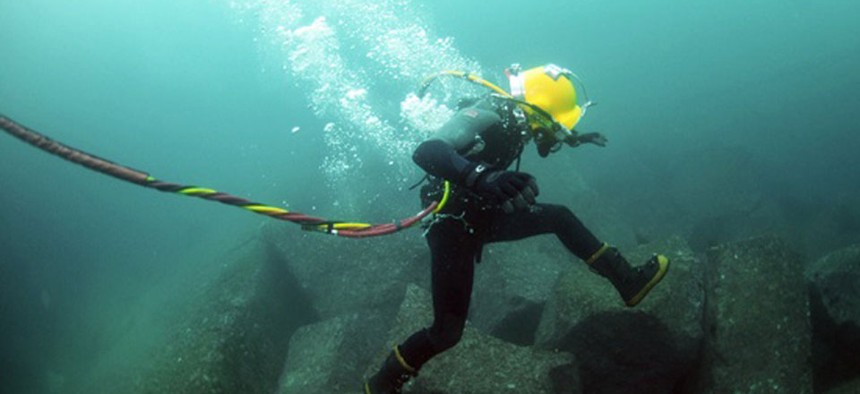
United States Navy
10 Creative Careers That Rely on Science and Math
Knowledge of STEM subjects isn't just essential for physicists or computer engineers. Fashion designers, zookeepers, and deep-sea divers also use it every day.
You probably know someone working in science: People in STEM fields accounted for about 6 percent of American workers in 2011. That may not sound like a high percentage, but it’s growing; the U.S. Department of Commerceanticipates that STEM jobs will grow 17 percent between 2008 and 2018, almost double the growth projected for the rest of the economy. Some of those jobs are in predictable fields—computer technicians, pharmaceutical developers—but others may be more surprising. STEM topics blend harmoniously with art, nature, construction, and other areas, making those fields more precise and enabling the creation and discovery of things far greater than the sum of their parts.
1. Meteorologist
Today, most people picture a meteorologist as the person gesturing to a map on the local news. But although this field started when early scientists diligently observed weather patterns, it became much more rigorous when they started trying to understand and forecast future conditions. Now, weather prediction requires the calculation of complex vectors, drawing on knowledge of physics, calculus, and earth science.
2. Taxidermist
Part biology, part artistry, preserving animal bodies requires an intimate knowledge of several different scientific disciplines. The taxidermist should understand an animal’s habitat in order to create accurate dioramas. The tanning of the animal’s hide also requires comprehension of the chemical processes necessary to keep it from decaying. Only once the hide is properly tanned and re-sewn can the aesthetic work begin.
3. Animator
The time-consuming, paper-based animation techniques of Disney’s golden years are a thing of the past. Today, most animators use computer programs to render the worlds of movies and TV shows. Often, young animators get into the field armed with a background in computer science and an affinity for art. Many animators also emphasizethe advantage of mastering multiple types of computer platforms and software.
4. Fashion Designer
Clothes of different cuts, sizes, and fabrics don’t just magically drape themselves on the human body. To create the initial pattern, a designer must craft a 3-D garment on 2-D fabric, which requires a knowledge of geometry. Of course, the garment has to fit the model in all the right places and be scaled up appropriately for different sizes, which means it also involves algebra and arithmetic. And in order to make a profit, the designer has to calculate the cost of the fabric and labor, then determine how much he or she should charge for a piece of clothing.
5. Park Ranger
Custodians of our national parks don’t have to be as frustrated as Ranger Smith, constantly arguing with Yogi Bear. Their work is made easier by strong backgrounds in forestry and conservation, and an intimate knowledge of the delicate ecosystems they work to protect. Employing their knowledge of botany and biology, they are sometimes called upon to help fight forest fires or take care of injured animals in the park.
6. Cartographer
Back in the days of the explorers, cartographers made maps using sundials, compasses, and telescopes, pinpointing and drawing out different locations with all the information available to them (which, in the early days of mapmaking, wasn’t very much). Today, cartographers use aerial imagery and digital databases to make maps, sometimes indicating three dimensions on paper or a screen. Even though computers now help with many calculations, cartographers need to know algebra, calculus, trigonometry, geology, and statistics.
7. Carpenter
When a carpenter starts to make a set of stairs, how does she determine how many to make? With math, of course! Carpenters use geometry to determine the dimensions for what they build, as well as during the building process. No one likes a slanted set of stairs!
8. Zookeeper
Although zookeepers have the awesome privilege of hanging out with exotic animals like lions and elephants, most of their time is spent caring for these creatures. Much like a veterinarian tends to a cat or dog, zookeepers care for the physical and mental wellbeing of the animals. They achieve this through careful observation and by using their training in biology and life science to treat any illnesses the animals may have.
9. Ship Captain
Even in these days of high-speed travel, the seas are filled with ships, many of them delivering cargo from one side of the world to another. When setting the course, a ship captain must make some sophisticated calculations, taking into account a vessel’s position, wind speed, current, tide, and cargo weight. The advent of GPS has aided this somewhat, but captains must still be able to use older technologies like maritime charts in case computers fail at sea. In addition to a knowledge of physics and computer science, a captain has to know how to work all the machinery on board, and will often be asked to log the ship’s pollution.
10. Diver
Scuba divers have some great job perks, like interacting with incredible wildlife and seeing the world in a new way. But they couldn’t do so safely without an intimate knowledge of math and physics. For even the simplest plunges, divers need to calculate the rate at which they should rise to the surface to avoid decompression sickness. They also need to know the laws of physics to determine how long their oxygen tanks will last given the water pressure at various depths.






